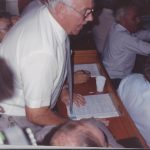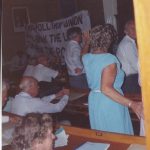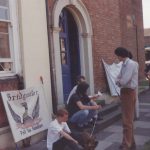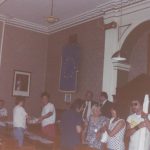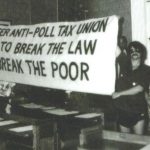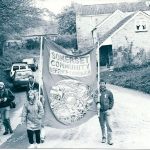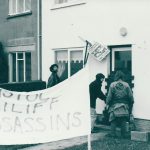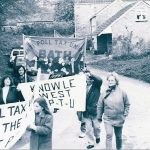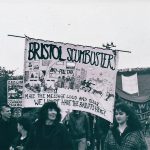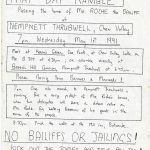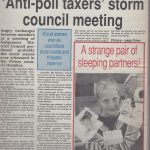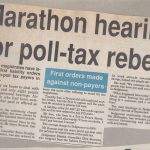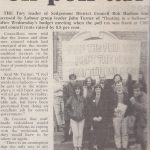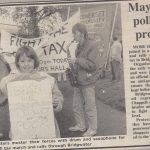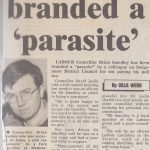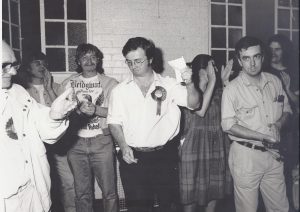
In 1381 the Government brought in a ‘Poll Tax’. The people rose up, formed a peasants army, stormed London and executed the ministers responsible. Here in Bridgwater they did the same, storming the houses of the guilty, destroying the bond papers that held feudal Britain together (or at least the poor in their servitude) and dragged out the poll tax collectors, placing their heads on spikes on the town bridge. You’d have thought they wouldn’t be doing that again in a hurry. But they did. In 1990 Margaret Thatcher’s Tories had been in power for 11 long years and, having ‘changed the face of Britain’ (to their benefit) now wanted to put the final nail in the coffin of socialism and decided a poll tax was just what was needed. The people fought back. And here in Bridgwater we fought back too.
I kept diaries and newspaper clippings from this period-these are in italics below
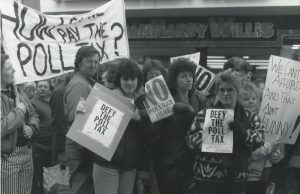
Places like Bridgwater had borne the brunt of Thatcher’s Tory reforms. A small but industry-dependent labour town, Bridgwater’s unemployment figures skyrocketed with every Thatcherite screw until by the mid 1980s they had reached the painful heights of the 1930s. This Union town, which had shown solidarity to Thatcher’s victims at every step of the way, to Miners in 84 -flying pickets protesting at Hinkley point or Dunball wharf, where scab coal was imported, stayed at Labour’s Unity House HQ and Printworkers in 86, when Trades Unionists from Bridgwater sent weekly minibuses full of supporters to stand alongside the 6,000 sacked workers of Rupert Murdochs ‘News International’ Empire battling Police and scabs in Wapping, was not going to lay down, even though by the second half of the 20th century Labour Bridgwater had been further belittled by having its red borough dismantled and replaced by the ‘Direct Rule from Cheddar’ that was Sedgemoor District Council.
On July 12th 1990 Sedgemoor District Council became the focus for the peoples fightback against the Poll Tax. A By-Election was to be held at this crucial moment and the people had the chance to vote on the key issue of the day.
For What This Poll Tax?
But how did we get here in the first place. The only other country in the world with a Poll Tax was Papua New Guinea. And they were getting rid of it! How did anyone think it right that the Duke of Westminster, who paid £10,000 in rates,would now pay just £400 in Poll Tax -the same as his Housekeeper, Chauffeur and Gardener? Well, the Tories did….
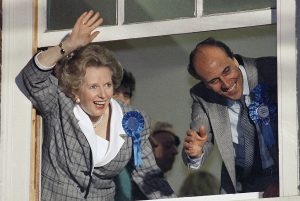
Thatcher brought in the Poll Tax – or ‘Community Charge’ as they tried to call it, in September 1989. Only they tried it out in Scotland first. There was hardly a Tory left north of the border anyway, so they didn’t matter. The Poll Tax was a flat rate tax that every single person had to pay no matter if they could or not. The concept behind the Poll Tax, from an arrogant all-powerful Tory dominated Britain point of view, was to lower the ‘burden’ of the ‘rates’ on those that paid most into the rates pool which paid for local services. The higher earners. That simple formula had provided the driver for a fairer redistribution of wealth in an over rich capitalist society and provided for a health service, local amenities and pretty much everything that low income earners needed to survive such a brutal system. But after 10 years of grinding the face, fingers and toes of the poor, the Tories thought they could get away with it. And so they even put it in their election manifesto for the 1987 election.
1987
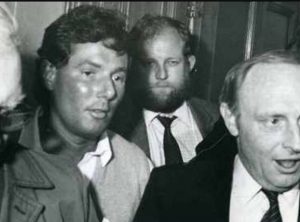
1987 had been another bad year. The opposition was divided. The SDP had broken away from Labour and then joined the Liberals, forming the ‘Alliance’ thereby splitting the anti-Tory vote and Labour was itself engaged in its own left-right battle with new leader Neil Kinnock aiming to win elections while trying to distance himself from militant miners, militant printers and militant militants, with little success.
Even in Bridgwater the Labour Party had suffered its worse ever defeat in history when a left-right battle over nuclear power fought itself out on the ballot papers of Sedgemoor halving representation down to just 5 Labour members.
But back in 1987 the people had again voted Tory. Well, in fact 42% had and 58% hadn’t. Still, the Tories had a 109 seat majority-enough to bring in a Poll Tax. Although most of the people saw it for what it was – a kind of Robin Hood in reverse – robbing from the poor to give to the rich -the Tories ploughed ahead believing they were invincible.
1988
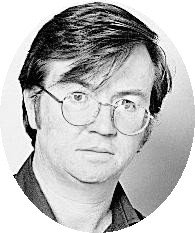 “In 1988 the ‘median’ wage for manual work was supposed to be £250 per week but many clearly earned a lot less due to the years of unemployment pushing down salaries and the breaking of Unions able to fight for higher wages. I was a multi drop van driver and earned £100 a week. Most of this went on basic survival. Rent and food. The addition of a ‘poll tax surcharge’ wasn’t even a budget consideration.”
“In 1988 the ‘median’ wage for manual work was supposed to be £250 per week but many clearly earned a lot less due to the years of unemployment pushing down salaries and the breaking of Unions able to fight for higher wages. I was a multi drop van driver and earned £100 a week. Most of this went on basic survival. Rent and food. The addition of a ‘poll tax surcharge’ wasn’t even a budget consideration.”
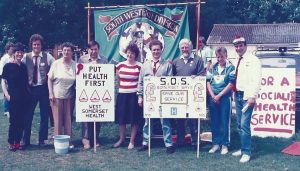
In Bridgwater in 1988 the Labour Party thought about how best to fight the poll tax locally. Prominent left wing members Glen Burrows and Dave Chapple, produced a draft campaign strategy involving organising meetings, petitions and national speakers. But the Poll Tax wasn’t yet imaginable by many people and the process was disheartening. The Trades Union leaders, in this trade union town, were reluctant to commit. TGWU leader Tom Searle strongly believed the Tories would change the legislation anyway before it got to be law and many in the local Labour branch also felt this.
The first Labour Party anti poll tax public meeting was held in St Georges Hall on 25 Feb in Bridgwater’s Victoria ward (the site of the 1990 By-Election) followed by Woolavington 8th March , Hamp 21st March and Eastover 10th May.
 “Meetings were poorly attended. I spoke at the Hamp one, and less than 10 people came. More successful meetings were held about the planned closure of the Mary Stanley Maternity Hospital at the time including one in May at the Town Hall with 140 people.”
“Meetings were poorly attended. I spoke at the Hamp one, and less than 10 people came. More successful meetings were held about the planned closure of the Mary Stanley Maternity Hospital at the time including one in May at the Town Hall with 140 people.”
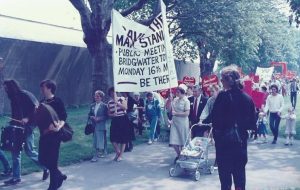
On 12 October the Poll Tax campaign was re-assessed at a Labour Party meeting with Glen Burrows putting the case for a shift to a non-payment campaign but the majority arguing for ‘staying within the law’.
On 9th November the Labour group of 5 on Sedgemoor voted against the Poll Tax but leader John Turner refused to condone law breaking echoing Neil Kinnocks description of ‘non payment’ as a ‘policy of despair’
1989
When in 1989 the Poll Tax became a reality in Scotland, the battle hotted up once more in local Labour parties.
On 24th April the Labour Party even voted to withdraw from a May Day Rally planned in the town for 5 days later and at which left wing speakers were to take the stage. Jimmy Wray a newly elected Scottish leftist Labour MP and Martha Osamor (mother of current MP Kate and at the time a Labour councillor in Haringay) turned up and spoke anyway.
On May 4th the Somerset County Council elections saw Labour winning 3 out of the 4 Bridgwater seats.
 “This was my second election. I’d stood for Sedgemoor during the civil war of 1987 as a Loyalist candidate and lost and now I stood for county – in a safe Tory seat – and again lost. I was the only candidate of course who mentioned the 1381 Peasants Revolt and impaling Poll Tax collectors heads on the town bridge…”
“This was my second election. I’d stood for Sedgemoor during the civil war of 1987 as a Loyalist candidate and lost and now I stood for county – in a safe Tory seat – and again lost. I was the only candidate of course who mentioned the 1381 Peasants Revolt and impaling Poll Tax collectors heads on the town bridge…”
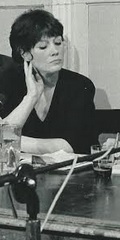
But the row rumbled on and was still going on as the actual introduction of the poll tax grew near. At a meeting on 13 December Glen Burrows argued that people shouldn’t pay the poll tax but Labour leader John Turner countered with “..it’s simply wrong to break the law “. He is supported by cllr Ken Richards who said ‘…it’s ok to break it yourself but don’t advise others to’!. John Turner adds The moral case was ‘pay and vote Labour’ to which Young Labour member Sarah Darke said “As a student nurse I’m not eligible for the 20% discount, I’m meant to pay the full 100%. I actually can’t afford to pay. What am I meant to do?”
The campaign even took to the stage when the local Sheep Worrying Theatre group wrote and performed their Christmas pantomime “Jack and the Poll Tax” that year.
In Scotland the introduction of the Poll Tax had caused riots and a strategy of ‘Can’t Pay Won’t Pay’ alongside organised community resistance to ‘Sherrifs Officers’-or Bailliffs, being sent in by Local Authorities to ‘physically collect unpaid poll tax’ or to ‘seize property to the estimated value’. Resistance was massive, angry and growing. Even the compromise decision to reduce the tax to 20% for students and the registered unemployed (so that everybody still had to pay something) actually meant that those in employment – whatever the low and derisory income to which Tory policies had sunk people-still had to pay 100%. For some of us in fact it wasn’t just immoral to pay this tax it was impossible anyway.
Resistance nationally was organised by the ‘All Britain Anti-Poll Tax Federation’ which was set up in November 1989 at the Manchester Free Trade Hall. Dominated by the Militant Tendency in each of the 20 regions (apart from here in the South West, where Independents ran it) it had the support of just 15 Labour MPs. Labour, along with most of the countries elected representatives, stopped short of advocating ‘non-payment’ and rather advised people to pay the tax, not break the law and vote it out next time round. A strategy that would fail disastrously. And of course, wasn’t how the people they represented had decided to fight back anyway. In fact 18 million people refused to pay.
1990
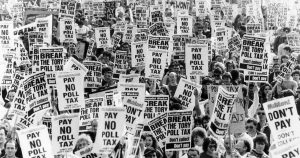
“Anti-Poll Tax Unions sprang up across the country to organise against the tax. As in 1381, Bridgwater was part of the National fightback. We set up a Bridgwater Anti-Poll Tax Union. We met in pubs. The Blake Arms, the Crown in St John Street. We designed our own logo -a phoenix rising up from the flames (of the poll tax bills we had burnt outside the Sedgemoor District Council offices). We organised Bailiff watches on the estates, Mackensies friends, to accompany victims at court cases and we organised protests and demos.”
Town Halls Under Siege
14th February 1990 was a turning point locally. Glen Burrows had had enough and unable to accept the Labour position resigned from the party.
 “I was a member of The Somerset Community Defence Campaign, which was an alliance of socialists from inside and outside the Labour Party and produced a magazine the ‘Somerset Clarion’ which at various times either myself or Dave Chapple were the editors of, was described by Labour right wingers as a ‘militant front’. However, the atmosphere was enough to see my selection as party rep at Conference that year overturned in favour of someone more mainstream. The only time in memory that had happened”
“I was a member of The Somerset Community Defence Campaign, which was an alliance of socialists from inside and outside the Labour Party and produced a magazine the ‘Somerset Clarion’ which at various times either myself or Dave Chapple were the editors of, was described by Labour right wingers as a ‘militant front’. However, the atmosphere was enough to see my selection as party rep at Conference that year overturned in favour of someone more mainstream. The only time in memory that had happened”
On 22nd February a packed meeting at Bridgwater Town Hall was addressed by Danny Burns, secretary of the Souh West anti-poll tax campaign group (and not a member of Militant) and voted overwhelmingly to form an Anti-Poll Tax Union in the town
On 3rd March 1990 there was an anti-poll tax demo in Taunton -peaceful compared to the riots in Brixton the following week. But in Bridgwater Labour Party members were at odds with the leadership position and at a meeting on 14th March voted to donate £15 to the new Bridgwater Anti-Poll Tax Union by 12 votes to 1. At a county council meeting Taunton Labour councillor Tony Sergeant publically advocated non-payment.
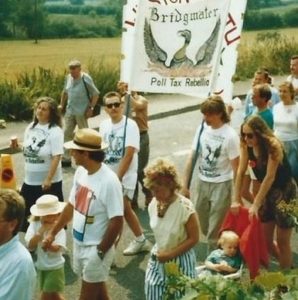
“On 15 March the Bridgwater Anti Poll Tax Union met at the function room of the White Hart and a week later the poll tax bills start to arrive. I got one for £358 which I immediately handed to my boss and asked for a rise to match it. No joy there. People were now facing a real choice about paying. Could they? Should they?”
I Predict a Riot
On March 31 1990 the Anti Poll Tax Federation called a mass demo in London to mark the introduction of the tax from Scotland to the rest of the UK. Organisers quickly realised numbers would be larger than the 60,000 capacity of Trafalgar Square and asked for it to be changed to Hyde Park, but the Tories said no. So on the march went to its original destination. And like all protests against the Tories in the 80s it was met with organised state violence. From Bridgwater and everywhere else, coaches went up. A quarter of a million people.
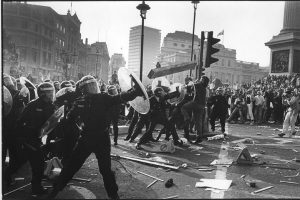
“I was in Whitehall when the first Police horses attacked and was pinned up against a statue of Spencer Compton (Britains second Prime Minister don’t you know). Escaping via Scotland Yard to Northumberland Avenue I was suddenly in no-mans land between another line of charging Policeman with batons drawn and a line of Poll Tax protestors (roughly by the Sherlock Holmes Pub). At the same time the South African Embassy went up in Flames. On the Lions podium at Trafalgar square we could see the speakers, Tony Benn, George Galloway and of course Jeremy Corbyn, surrounded as more Police cavalry circulated, bowling over protestors in their wake. 113 people were injured and 340 arrested.”
The Struggle moves to the Town Halls
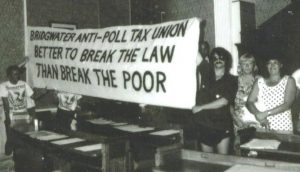
Back in Bridgwater, as in Town Halls across the country, local councils were now compelled to set their rates and introduce the Poll Tax on their own people. The Tories were set on self-destruction but their party was populated by a dying breed of die hards so into the valley they went. Labour was divided. At the 1988 Conference the Party had voted against non-payment with Kinnock saying ‘Law makers must not be law breakers’. Labour decided a policy of ‘protest’, but the people had decided to ‘resist’.
But could there be a two-pronged strategy to defeat the poll tax? Labour was rising in the opinion polls and at the same time Council meetings were becoming the sites of mass protest. The strategy had been thrashed out across Scotland in 1989 with debate on tactics ranging from ‘non registration’ to ‘non payment’ to ‘non implementation’ to ‘non collection’. Labour seemed to be coming down on a ‘wait for us to win the next election’ position. But people weren’t in a mood to ‘pay and wait’..
On 7th April the Bridgwater anti poll tax union gave their response on the Brewery Field-adjacent to the then Sedgemoor District Council offices – and all turned up and burnt their bills. The Bridgwater APTU went on to deliver 30,000 protest leaflets around Sedgemoor. 50 people at a time were attending public meetings every Tuesday at 7.30 at the Blake Arms. In an article in the Somerset Clarion people were urged not to pay and reminded ‘’non payment is not a criminal offence, it’s a civil offence. The court has to issue a liability order and there are limits to the ammounts the council can attach”.
A By-Election is called
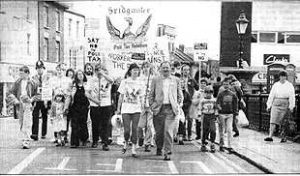
On May 12 the Bridgwater May Day Rally is led by left wing MPs Ken Livingstone and Dawn Primarolo. The Bridgwater Anti-Poll Tax Union phoenix banner proudly leads the procession from Cranleigh Gardens across town bridge.
On June 13th the Victoria ward By-election is finally called as Labour councillor Rene Bisset , only elected in 1987,stands down.
In a heated battle for selection it’s a left-right choice. Softly spoken ‘moderate’ and full time social worker Julian Taylor faces wild eared militant and former ‘socialist worker’ Brian Smedley. A single vote decides it. The Labour candidate will be a prominent member of the Anti Poll Tax Union campaigning for non-payment.
The Election Campaign
There were 4 Candidates. Brian Smedley for Labour, Dierdre O’Rourke for the Social Democrat Liberal Alliance and Peter Stothert for the Greens. For the Conservatives it would be Gill Slocombe.
 “In 1990 Gill Slocombe wasn’t the lovable dowager Duchess of Durleigh that she is now, she was the Princess of Pretty Much Anywhere and the star Tory pitbull thrust into the Victoria limelight at this moment. Selected by local Tories to defend the Poll Tax she chose to brand me as a ‘militant’.. The Liberals and the Greens turned up to a meeting and we all agreed a fair fight. Mrs Slocombe however decided to start off by telling me and Cllr Burrows to ‘get on a plane to Romania’ instead of ‘bleating about class and the poll tax’ adding that we should ‘thank our lucky stars that we live in a country where hardship as Romanians know it does not exist’. At least she didn’t say hardship ‘didn’t’ exist at all…but no, instead she decided to tell us that ‘living standards have increased to their highest levels ever’.
“In 1990 Gill Slocombe wasn’t the lovable dowager Duchess of Durleigh that she is now, she was the Princess of Pretty Much Anywhere and the star Tory pitbull thrust into the Victoria limelight at this moment. Selected by local Tories to defend the Poll Tax she chose to brand me as a ‘militant’.. The Liberals and the Greens turned up to a meeting and we all agreed a fair fight. Mrs Slocombe however decided to start off by telling me and Cllr Burrows to ‘get on a plane to Romania’ instead of ‘bleating about class and the poll tax’ adding that we should ‘thank our lucky stars that we live in a country where hardship as Romanians know it does not exist’. At least she didn’t say hardship ‘didn’t’ exist at all…but no, instead she decided to tell us that ‘living standards have increased to their highest levels ever’.
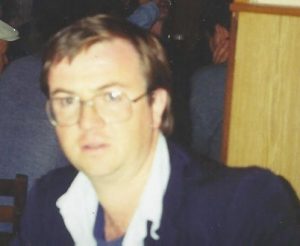
The first day of the election I went down Brendon Road-but sitting councillor Ken Richards had beat me to it and made sure that every single window had a ‘vote Labour’ poster in it. The campaign went well. Labour members and anti-poll tax union members worked together and the voters turned out on the day.”
Labour set up Campaign HQ in Shirley Bissets house on Feversham Avenue directly opposite the Polling Station so it was a short walk across the road to the count at 10pm.
On July 12th the result was announced in St Georges Hall. Labour had won a convincing victory with more votes than all the other 3 parties put together. Labour (Smedley) 673, Con (Slocombe) 294, Lib (O’Rourke) 163 Green (Stothert) 76.
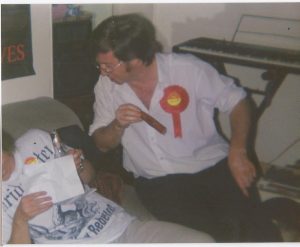
“The election picture taken exactly at the announcement of the result shows the strength of the alliance. Left to right there’s Labour stalwart Maurice Brown, APTU activists Bob Ormrod and Andy Pole, myself, my partner Elaine di Campo, Venue journalist Eugene Byrne who went on to quiz Mrs Slocombe afterwards about her #militant accusations’ and finally Adrian Fraser on the edge of shot. In my extremely short victory speech I said ‘the Tory Candidate tried to brand me a militant, well theres 673 other militants in Victoria and we’re all against the Poll Tax.! Then we went back to my West Quay flat and had a party.”
Occupying the Council Chamber
But it didn’t end there. On August 1st at the next Sedgemoor Council meeting the Anti Poll Tax Union didn’t just protest outside they stormed the building. At the time Sedgemoor met at The Old Priory offices. Their banners declared ‘Better to Break the Law Than Break the Poor’.
“The Tories were apoplectic with rage and indignation. Several stormed out, some responded aggressively to the protestors. Only the 4 Labour councillors remained in our seats.”
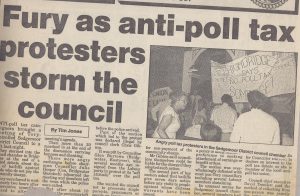
Cllr Glen Burrows had a motion already prepared ‘opposing the use of bailliffs’ She now had a seconder. The motion called for the council not to prosecute single parents, pensioners or people on income support for non payment. SDC lawyer Chris Gibson ruled the motion potentially illegal saying ‘councillors could themselves be liable for the charge if they adopted such action’. Cllr Burrows added a clause about 7 days notice for bailiffs accusing Sedgemoor of choosing Bailliff action rather than attachments. The motion was defeated with just Burrows and Smedley supporting, meanwhile tempers frayed when Tory heavy Des Roach referred to Cllr Burrows as ‘a girl’ saying “This ‘girl’ has been speaking for 7 minutes!!’ to which she replied “How dare you call me a girl. If I had been Bernadette Devlin 15 years ago I would have smacked you in the gob! I am a woman of 41!”.
Labours Cllr Ken Richards told Roach to apologise and when he wouldn’t added “Then sit down you’re a bloody idiot!”
The campaign continues (and gets nasty)
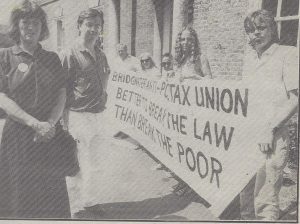
On 30th August Sedgemoor started prosecuting people for non payment of the poll tax.
“I attended these court hearings and was thrown out for refusing to stand up ‘in respect’ for a Poll Tax Magistrate. I’ve consistently refused to stand for so called dignatories ever since.”
Ken Trunks was the first Bridgwater person jailed for non-payment. He served 14 days. Ken, then 59, owed £460 and was sent to Bristol’s Horfield Prison. 1,000s more had wages attached or bailiffs used against them. Many were dragged through the courts to give Sedgemoor the legal powers to do this.
The Battle against the Poll Tax lasted throughout 1990 and into 1991. In surveys some 80% of the people said they were against it. This had an effect on the Tories who finally had to face up to the growing unpopularity of their Iron Leader. In November 1990 Michael Heseltine stood against her for the leadership job and when staring her lack of support in the face she finally resigned.
 “I was working as a van driver and turned the radio on after I’d fuelled up for the morning. It was 22nd November and the first news item was Thatcher resigning. I drove straight around to the Bridgwater Magistrates Court where the latest victims of the Poll Tax were being summonsed, fined or imprisoned for non payment. The Anti-Poll Tax Union was there as always to support them. I burst into the courtroom and shouted the news of Thatchers resignation. APTU members cheered. Allan Challenger, a solid activist throughout the campaign, stood up and pointed at the magistrates shouting ‘Your leaders gone now its time for YOU to go!’
“I was working as a van driver and turned the radio on after I’d fuelled up for the morning. It was 22nd November and the first news item was Thatcher resigning. I drove straight around to the Bridgwater Magistrates Court where the latest victims of the Poll Tax were being summonsed, fined or imprisoned for non payment. The Anti-Poll Tax Union was there as always to support them. I burst into the courtroom and shouted the news of Thatchers resignation. APTU members cheered. Allan Challenger, a solid activist throughout the campaign, stood up and pointed at the magistrates shouting ‘Your leaders gone now its time for YOU to go!’
1991
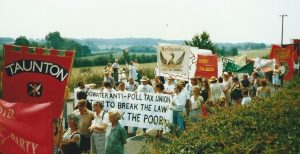
In May 1991 the Sedgemoor District Council elections saw a massive swing to Labour. Up from 4 to 12 councillors including members of the APTU.
“I was re-elected in Victoria and although Glen had stood down in Eastover, her replacement was Labour’s Mac McCausland who had no hesitation in seconding a motion on banning the use of baillifs in Sedgemoor.”
But it wasn’t all grim class struggle. One event saw the Bridgwater APTU re-enacting the march by their ancestors from Bridgwater to Ilchester in 1381, then the county town and county gaol.
“A group of us set out from the Cornhill and walked the 23 miles. 3 of us made it. I remember as we reached Ilchester saying to the other 2-Andy Pole and Gwyn Holland- it’s not a race. So they paused. At which point I dashed across the finish line. History will judge whether it was a race….”
Bricking up the Bailliffs
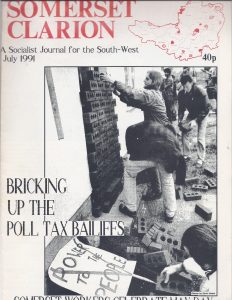
In 1991 the Somerset Anti Poll Tax Unions celebrated May Day by organising a visit to Nempnett Thrubwell and the home of Head Bailliff John Roach, who, it seems was having some works done to his house. APTU Members turned up , issued him with a ‘distress notice’ as he had done to 1,000s of Poll Tax victims, and then proceeded to use the spare bricks to brick up his doors and windows and then held a mock auction of the goods in his garage.
When interviewed by the press, Glen Burrows said “I thought it was a very successful way of giving people confidence about handling baillifs. The use of bailiffs by councils is meant to frighten people into paying money they cant afford to pay. It really is futile for councils to be spending all this money chasing people who will not be able to pay. The Bridgwater Anti Poll Tax Union is calling for an amnesty and negotiations with non-payers on an individual basis-this would be far more cost effective for the councils”.
The misery went on
2 years after the demise of the poll tax some 16,000 people in Sedgemoor were still paying in instalments and over 1,000 hadn’t paid a penny at all. Councils were in chaos and the courts were clogged up.
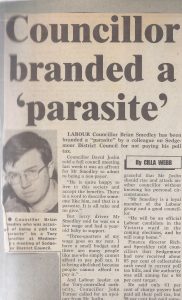
“2 years later and I still hadn’t been personally taken to court so I told the council I was ‘getting bored of waiting for a summons’. This was of course a red rag to a field of Tory bulls. Cllr Brown accused me of ‘breaking the law and (more importantly) ‘the code of conduct’. Cllr Noreeen Ellis-Jones demanded that I be put at the top of the list and sent straight to court. Tory Leader Bob Hudson was more circumspect saying ‘we don’t want to make a martyr out of cllr Smedley…’
But Thursday 9th January 1992 I was in court alongside fellow councillors Pat Morley and Mac McCausland plus anti poll tax union activists Dave Chapple and Andy Pole. We were all issued with liability orders. I told the Press ‘I can’t afford to pay but I’m not paying on principle. I was elected on a non-payment platform and I will continue on that’.
When I was elected to council there was no such thing as a ‘wage’ for councillors. You got £13 expenses per meeting. In fact I’d lose a days pay (yes, £20…) in order to attend as , being a driver, I couldn’t do half a drive and then leave my van in say Cornwall. So I was losing money by being a councillor. Then they discovered that they had the power to attach my wages at source-which my bosses were obliged to go along with. So I lost again. Over the next couple of years though I made a point of working very closely with SDC’s Finance officer Richard Spreckley to ensure that when they did this to anyone who simply couldn’t afford it then the attachment was absolutely the smallest amount possible. I did up to 100 cases such as this and was naturally branded a ‘parasite’ in the local press by Tory councillor David Joslin.”
Poll Tax Defeated
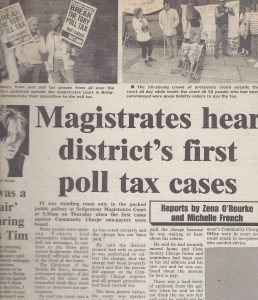
The Poll Tax had been defeated by the mass campaign against it. In February 1990 there had been riots around Town Halls as councils brought in the tax. In Trafalgar square that March there was major civil disobedience, repeated again at Brixton in October. The first national audit of the Poll Tax showed that 18% hadn’t paid in the shires and 27% hadn’t paid in the cities. After the tax was abolished it rose to 50%. The mass campaign of the Anti-Poll Tax Unions played the major part in bringing down the Poll Tax – but the political pressure of elections was also a factor. In March 1990 Labour won the Mid-Staffs by election with a swing of 21%-the highest since 1934 and in March 1991 the Liberals won the Ribble Valley by-election in a display of anti-tory tactical voting that kicked them out of their 4th safest seat. That electoral pressure led to Michael Heseltine announcing the abolition of the Poll Tax within weeks, to be replaced by ‘the Council Tax’ in 1993, a tax to fund local government once again based on ability to pay and property values.
But there was a sting in the tale. Although the post-Thatcher Tories got rid of the Poll Tax so many people had chosen the option of going into hiding and not even registering, that when they turned up to vote, they weren’t actually on the register anymore. This is what they meant by ‘poll tax’. It was a tax on the polls. A tax on voters. And, of course, a tax on poorer voters. So many were unable to vote that in 1992 the Tories won again and it took another election to get rid of them a few years later. But..at least they’d never be back after that…….or so we thought.

